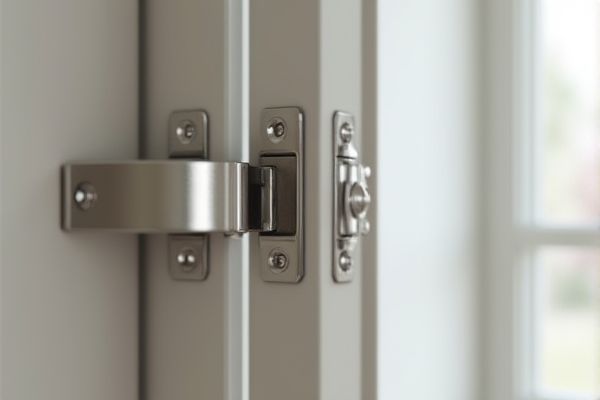
Soft-close hinges offer a smooth, silent closing mechanism that prevents doors from slamming, enhancing the longevity of your cabinets and improving overall kitchen comfort. Explore the rest of the article to discover which hinge best suits your needs and how it can transform your cabinetry experience.
Table of Comparison
| Feature | Soft-Close Hinge | Standard Hinge |
|---|---|---|
| Closing Mechanism | Controlled, slow closing | Manual, fast closing |
| Noise Level | Quiet, noise-free closure | Loud, slamming noise |
| Durability | Higher, reduces wear | Standard wear and tear |
| Installation | Requires specific mounting | Simple, universal mounting |
| Cost | Higher price point | Lower price point |
| Applications | Modern cabinets, premium furniture | Basic cabinets, budget furniture |
Introduction to Cabinet Hinges
Cabinet hinges are essential hardware components that enable doors to open and close smoothly while providing stability and alignment. Soft-close hinges incorporate a hydraulic mechanism to gently slow the door's movement, preventing slamming and reducing wear over time, whereas standard hinges rely solely on manual control without dampening features. Choosing the right hinge impacts your cabinet's functionality and longevity, with soft-close hinges offering enhanced noise reduction and protection for your cabinetry.
What is a Standard Hinge?
A standard hinge is a basic mechanical device used to connect doors to cabinets or furniture, allowing them to pivot open and closed. Unlike soft-close hinges, standard hinges do not have built-in mechanisms to control the speed or prevent slamming, which can lead to noise and potential wear over time. Choosing the right hinge type impacts your furniture's durability and user experience by balancing cost and functional smoothness.
Understanding Soft-Close Hinges
Soft-close hinges prevent cabinet doors from slamming shut by using a hydraulic or spring mechanism that gently slows the closing motion, enhancing durability and reducing noise. Unlike standard hinges, which allow doors to close abruptly and can cause wear over time, soft-close hinges provide smoother, quieter operation, ideal for frequent use in kitchens and bathrooms. You benefit from improved cabinet longevity and a more refined user experience with soft-close technology.
Mechanism: How Each Hinge Works
Soft-close hinges use a hydraulic or spring mechanism that slows the door's movement as it approaches the closed position, preventing slamming and reducing wear. Standard hinges operate on a simple pivot system, allowing doors to open and close freely without any built-in damping or controlled motion. The soft-close mechanism enhances durability and noise reduction by absorbing impact energy, whereas standard hinges rely solely on manual control.
Installation Process: Soft-Close vs Standard
Soft-close hinges require precise alignment during installation to ensure the damping mechanism functions properly, often involving adjustable screws for fine-tuning the closing speed. Standard hinges have a simpler installation process with straightforward mounting and fewer adjustment points, making them quicker to install but lacking customizable closure. Both hinge types typically fit standard cabinet door setups, but soft-close hinges may need additional tools or instructions to achieve optimal performance.
Durability and Longevity Comparison
Soft-close hinges typically feature damping mechanisms that reduce stress on cabinet doors by preventing slamming, significantly enhancing durability and extending lifespan compared to standard hinges. Standard hinges, lacking cushioning components, endure greater wear and tear from frequent impact, often resulting in faster degradation and the need for replacement. The advanced engineering of soft-close hinges also minimizes metal fatigue and loosening over time, contributing to superior longevity in high-use environments.
Noise Reduction and User Experience
Soft-close hinges significantly reduce noise by employing dampening mechanisms that prevent doors from slamming shut, enhancing the overall tranquility of living spaces. This feature improves user experience by providing smooth, controlled closing action, minimizing wear and tear on cabinets and reducing the risk of finger injuries. Standard hinges lack these noise reduction benefits, often resulting in louder, harsher door closures that can disturb household peace and decrease long-term durability.
Cost Differences: Soft-Close vs Standard Hinges
Soft-close hinges typically cost 30-50% more than standard hinges due to their integrated damping mechanism and advanced engineering. While standard hinges offer basic functionality at a lower price point, soft-close hinges provide enhanced durability and noise reduction, which can justify the higher initial investment. Your choice depends on balancing upfront costs with long-term benefits like reduced wear and improved user experience.
Maintenance and Repair Considerations
Soft-close hinges require less frequent maintenance due to built-in damping mechanisms that prevent slamming and reduce wear on cabinet doors. Standard hinges often need periodic tightening and lubrication to maintain smooth operation, increasing the likelihood of repairs over time. While soft-close models may have a higher initial cost, their durability and lower repair frequency result in long-term savings and less maintenance effort.
Which Hinge is Best for Your Cabinet?
Soft-close hinges offer smooth, silent closing that protects cabinets from damage and extends their lifespan, making them ideal for high-use areas. Standard hinges are more affordable and simpler to install but lack the cushioning feature, which can lead to noise and wear over time. Your choice depends on whether you prioritize durability and quiet operation or budget-friendly, straightforward functionality.
 homyna.com
homyna.com